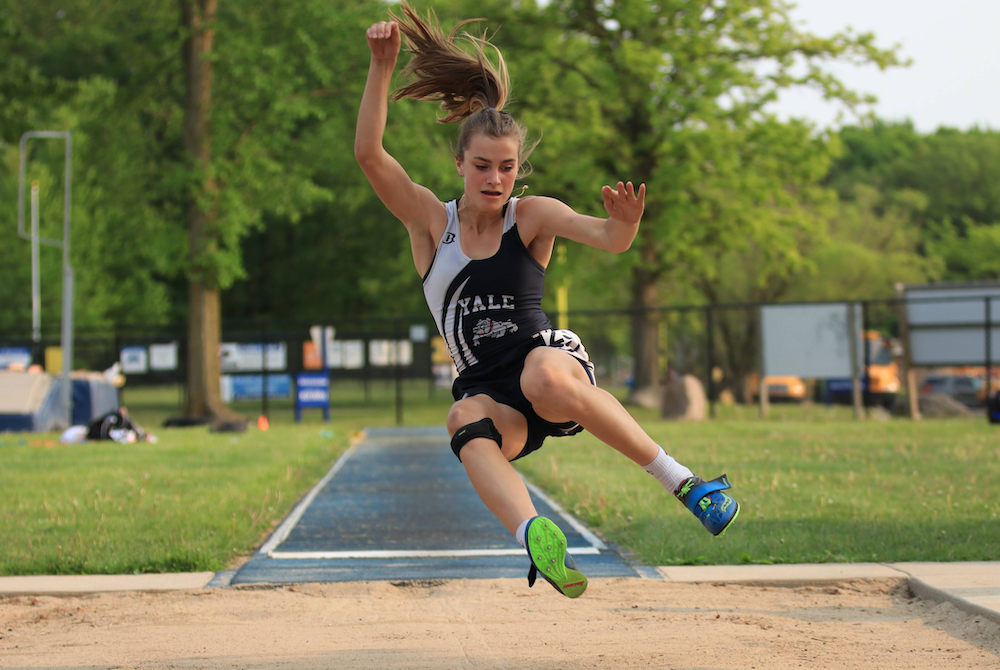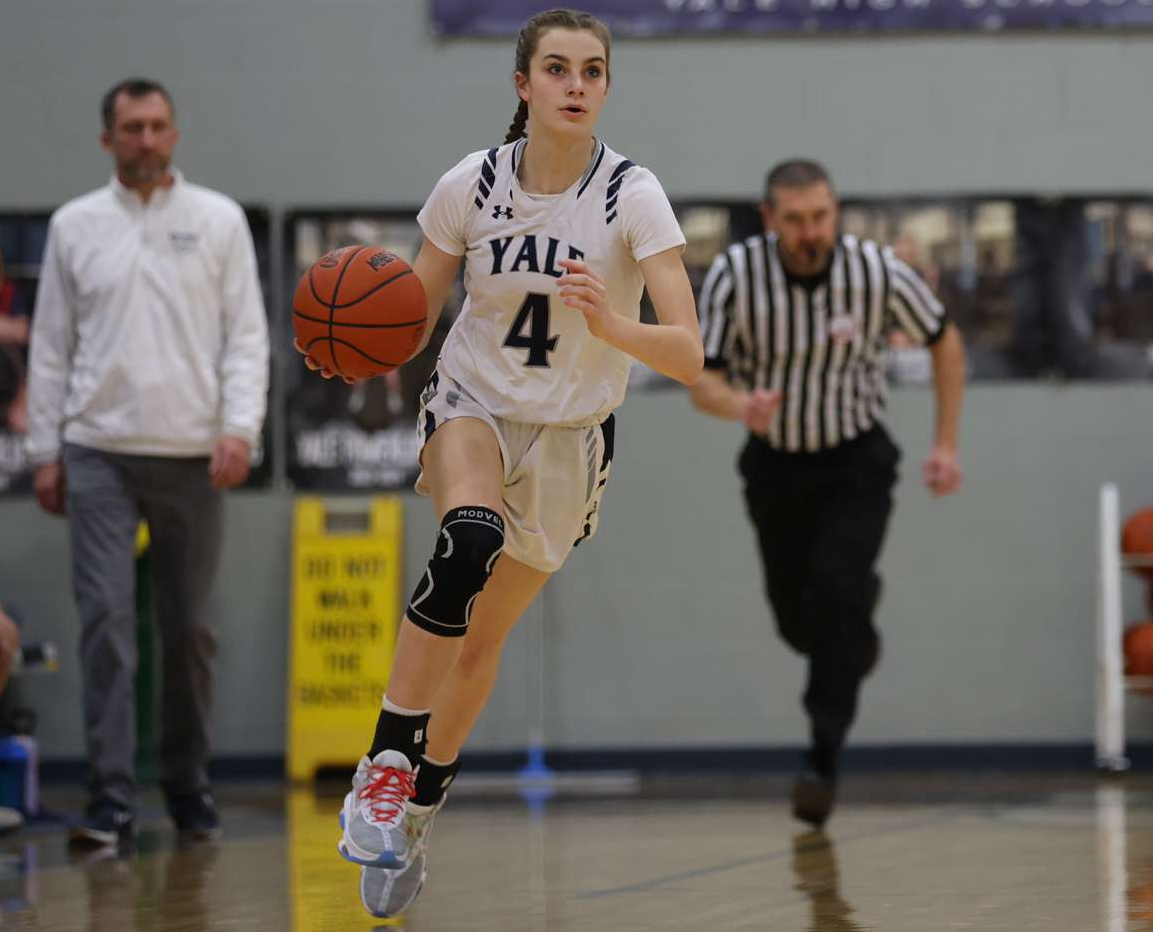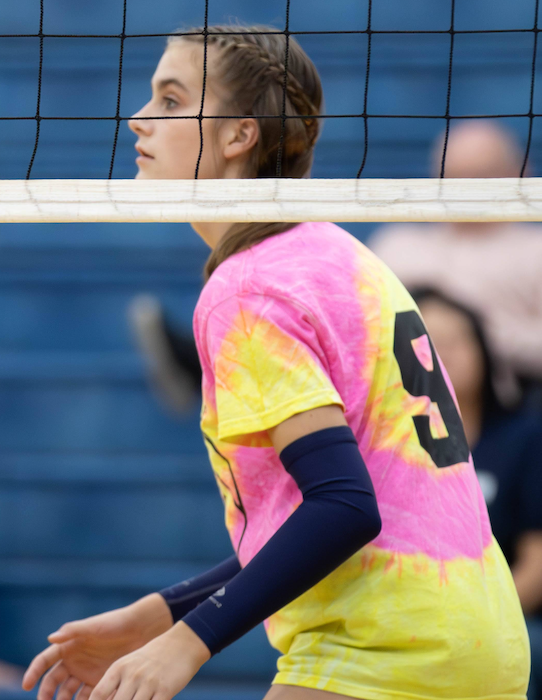
Powerful Voice for High School Sports
December 19, 2014
By Geoff Kimmerly
Second Half editor
Paul Carey was home from the U.S. Army only a few months and just shy of 25 years old when Beal City embarked on its first trip deep into the MHSAA boys basketball tournament.
On the call for local radio station WCEN from gyms at Saginaw Arthur Hill and Lansing Sexton, Carey served as the voice of the previously “laughable” Aggies as they reached the Class D Semifinals before falling just six points short of playing for the title.
“All of Beal City emptied out. They’d never had anything before,” Carey recalled during his annual Thanksgiving weekend visit to the MHSAA Football Finals at Ford Field. “When I got home, within the next two weeks I got a letter from every citizen of Beal City thanking me for broadcasting their games. That’s the kind of appreciation that meant so much.”
During 42 years on the airwaves, Carey was best known as a voice of the Detroit Tigers bounding out of transistor radios all over Michigan, thanks to WJR’s powerful signal.
But for the state’s high school sports community, his legacy is similarly memorable as the voice of the longtime football and basketball scoreboard show and a voter for various all-state teams and wire polls over the decades.
Now 86 and retired since 1991, Carey remains a regular during the first day of the Football Finals, taking in games he broadcast for the MHSAA during the late 1970s and that continue to hold his eye as they have for more than a half-century.
“It was a passion of mine. High school sports always has been,” Carey said. “I think because my dad was a high school coach, and teacher initially, and my brother was a high school coach and teacher, I just grew up in families that appreciated coaching and athletics. I was not a great athlete, but it kept my hand in following sports that way.”
Now, the scores
Carey partnered with Ernie Harwell for Tigers radio broadcasts from 1973-91, including during the march to the 1984 World Series championship. He was named Michigan Sportscaster of the Year six times and to the Michigan Sports Hall of Fame in 1992.
But Carey’s early career included sitting on top of a car, plugged into a phone pole, for a Sacred Heart football game at old Fancher Field just a few blocks from his family’s Mount Pleasant home. Among many more accolades are a Distinguished Service Award from the Michigan High School Coaches Association and a place in the Basketball Coaches Association of Michigan Hall of Fame.
In fact, the start of his weekly announcing of statewide football and basketball scores preceded his baseball career by 16 years and ended two months after he announced his final professional out.
The Michigan High School Scoreboard show was a staple of WJR’s late Friday nights from 1957-91. Carey would read every score he could collect from a variety of sources, often organized by league and with state rankings and context mixed in.
His idea came from something similar read by Len Colby for Kalamazoo’s WKZO. Carey’s brother Terry was coaching at Niles during the second half of the 1950s, and he and other coaches would get together to listen to the Friday night scores from the southwestern part of the state.
Carey, who left WKNX in Saginaw for WJR in 1956, explained to then-sports director Bob Reynolds that the station’s strong signal could provide for a truly statewide scoreboard experience.
Carey then connected with Edgar Hayes of the former Detroit Times, who gave the OK for Carey to call the paper on Friday nights to get scores from the Detroit metro area. For the rest, Carey relied on wire services – there were three at the time – who relied on newspapers from all over Michigan to call in scores over the course of an evening.
Before every Friday during high school football season – and later Tuesdays and Fridays during boys basketball season – Carey typed up lists of games based on schedules in the newspaper, with spaces to add scores. More than a few times, Carey raced down a back ramp at Tiger Stadium after a Friday night game, back to the WJR studio, with 15 minutes to prep for the show’s 11:30 p.m. start.
“If the Flint Journal, the Grand Rapids Press, the Traverse City paper didn’t call in scores to the AP, then I was out of luck too. And that happened all the time,” Carey said. “I would call back occasionally, say, ‘Did you get anything more?’ It was a rat race.”
The show originally was set for 10 minutes and then extended to 15. American Airlines sponsored a record show that followed, and Carey’s scoreboard show had a sponsor only once in 35 years. Finishing up on time was expected, even with more than 200 scores to read.
But Carey said he always went 20 minutes, sometimes 25.
“Because I wasn’t done. I just kept right on going,” Carey said. “Jay Roberts did the all-night show most of the time, and he was patient with me. He didn’t say too much on the air about ‘that guy ahead of me took all of my time.’”
Carey continued the “rat race” until his final scoreboard show, Dec. 20, 1991. He retired from WJR at the end of that calendar year. And it's important to note: Carey was never paid a dime extra for doing the program. .
“I think Paul is really just a sports fan, and that came across to the listener on his broadcasts,” MHSAA historian Ron Pesch said. “Paul would gather as much as possible off the wire. He'd interject if scores were missing from sections of the state. Press polls from the Free Press, News, AP and UPI were big, so he could point out close calls and upsets.
“He provided immediacy, or the closest thing to it in the days before cable TV and the Internet, and because of his scoreboard show, you could get the results before the morning paper. For listeners, he brought life to something as simple as game scores.”
First team all the way
Carey, who resides in Rochester, also served as the engineer on Tigers broadcasts for 16 years, through 1990. He broadcast Pistons games on the radio for six seasons and did the first broadcast of a Central Michigan University football game, in 1949.
Harry Atkins, covering Detroit’s teams while with The Associated Press for 29 years including the last 21 as its sports editor for Detroit, took note of his colleague's hard work – and especially that Carey was one of few broadcasters who was a journalist in addition to a voice.
That made Carey's other major role in high school sports a natural fit.
Atkins split The Associated Press all-state selection panels for football and basketball into 11 regions, and Carey represented the Detroit area for a number of years. He also was a longtime voter in those sports' weekly polls.
“Paul is just that kind of guy. He thought it was important and he made time in his busy schedule to do it,” Atkins said “And it had an impact on the other 10 voters on the All-State panels, too.
“Some of them were from small out-state newspapers or radio or TV stations. Yet every one of them knew who Paul Carey was. And when he spoke, of course, with what often is called "The Voice of God," those voters paid attention.”
And he still does, as well.
At the end of each fall, Carey still puts together a compilation of the three high school all-state football teams – Associated Press, Detroit Free Press and Detroit News – and files them with years of research and results.
“It’s important to me. Nobody sees it but me, but I get a certain kick,” Carey said. “Once in a while I’ll see a kid playing at Central, Western or (Michigan) State or Michigan, and they’ll say he came from Clawson. I’ll go into my all-state collections, say that would’ve been 2009 he played, and I find a name.”
In addition to the Football Finals on WJR, Carey was part of the Baseball Finals broadcasts into the early 1990s, continuing to contribute even after his retirement from his fulltime gig.
He spent high school games over the years sitting next to legends like the Free Press’ Hal Schram and remembers when current Free Press longtime scribe Mick McCabe was just a rookie. One of Carey's final broadcasts was a 1992 Baseball Final with his nephew Mike Carey, who continues to broadcast MHSAA championship games to this day.
“I am eternally grateful to Paul Carey. His contribution to high school sports in Michigan has been great and significant,” Atkins said.
“We are lucky to have him.”
PHOTO: Paul Carey (left) and nephew Mike Carey broadcast the MHSAA 1992 Class D Baseball Final between Hillman and Athens for PASS.

Yale's Dykstra Wasting No Time Showing Superior Multi-Sport Potential
By
Paul Costanzo
Special for MHSAA.com
March 28, 2024
Sadie Dykstra’s already long list of accomplishments from less than two years of high school – three all-state medals, multiple all-conference awards and a league MVP to name a few – may seem shocking.
 And to most, it justifiably is.
And to most, it justifiably is.
But it’s come as little surprise for those in Yale who saw her grow up and do, well, anything.
“I’ve always known that she’s kind of special,” said Yale boys track coach and Dykstra family friend Brian Bearss. “She was that kid that, when other kids would be playing and learning how to ride their bikes, here comes Sadie and she’s yelling, ‘Look at this,’ and standing on the seat riding the bike. She’s always been exceptional as far as being an athlete.”
Dykstra is entering her sophomore track & field season at Yale and has already established herself as one of the best female athletes in the state. Want to argue against that? Check out this résumé:
Volleyball: Two years varsity, second-team all-Blue Water Area Conference as a sophomore.
Basketball: Two-time first-team all-BWAC selection, BWAC all-defense and BWAC MVP as a sophomore, BCAM all-state honorable mention as a freshman, sophomore all-state honors still pending.
Track: Unbeaten in the BWAC as a freshman with four league titles (long jump, 100 hurdles, 300 hurdles and 1,600 meter relay), three all-state finishes at 2023 Lower Peninsula Division 2 Finals (fourth in long jump, fifth in 100 hurdles, sixth in 300 hurdles).
Again, just a sophomore.
“I can’t believe that I get to coach her,” Yale girls track coach Ashley Garofalo said. “She has a drive and a mindset that I can’t teach somebody. Nobody can teach you to have this. She gives every single thing that she has in every single sport. I think it does help when you’re so good at it. It makes you want to do it more.”
 Basketball gets Dykstra’s most attention and it’s the one she’d most like to play at the next level. The 5-foot-11 guard is getting interest already from Division I college programs.
Basketball gets Dykstra’s most attention and it’s the one she’d most like to play at the next level. The 5-foot-11 guard is getting interest already from Division I college programs.
But it wouldn’t be right to say her heart is with one sport or another.
“I enjoy all my sports,” Dykstra said. “I like all my teams. I have a different team for each one, and I get along with all those girls. I think each one, it flows into the next one, and helps strengthen things for my other sports. Volleyball helps my legs for basketball. In basketball, I’m getting in shape for track.”
You don’t have to look far to find where Dykstra gained her love for athletics. Her parents, Kerry and Brad, both played basketball at Calvin College. Kerry graduated as Calvin’s all-time leading scorer in 1999 and is still sixth on the all-time list. She also served as Yale volleyball coach for 10 years, just recently stepping down.
Brad was a two-sport athlete at Calvin, playing baseball as well. He also played baseball at Grand Valley State. He coached basketball at Yale from 2006-10.
“We’re a very sporty family,” Sadie Dykstra said.
So, when it came time to enter high school, there was never a thought of specializing.
“I came in with the mindset of, I’m going to play three sports each season and enjoy them, too,” Dykstra said. “I don’t want to be in them and have them be the most awful things in the universe. I came in with the mindset of enjoying all three sports.”
 While basketball is her current collegiate goal, she did say that competing in basketball and track & field would be something she would consider if given the opportunity. Bearss said Dykstra has Division I potential in track & field, adding that heptathlon could best suit her.
While basketball is her current collegiate goal, she did say that competing in basketball and track & field would be something she would consider if given the opportunity. Bearss said Dykstra has Division I potential in track & field, adding that heptathlon could best suit her.
But there are still two more years to figure that out. The next thing for Dykstra to enjoy is track, the sport in which she had the most early success. And while outdoor meets are still a couple weeks away, she’s already locked in.
“She’s just a natural leader, and I think that’s why she’s so disciplined,” Garofalo said. “(Tuesday), I was going over a workout with somebody else, and she just started her warm-ups on her own. She’s not afraid to lead 60 other kids, even though there are juniors and seniors.”
Dykstra has big goals for this spring, mostly based around performance marks. She’s eyeing the Yale school long jump record of 18 feet, 1¾ inches, which is less than an inch longer than her personal best of 18-1. She’d like to move that record closer to 19 feet.
Her 100 hurdle PR (personal record) sits at 15.59 seconds, and she’d like to knock that into the low 15s or even high 14s. For the 300 hurdles, where her PR is 47 seconds, she’d like to get down to 45.
“I have big goals, and I think I can get to them,” she said. “But that’s something for the end of the season to play out and see how that goes.”
Anybody who’s watched her wouldn’t doubt that Dykstra can reach those goals. And that list, along with those accomplishments, continues to grow.
“Last year we went to Ortonville Brandon, and we had really nice weather that day and the competition was really good – a lot of schools there,” Bearss said. “Even with all of those great athletes, you could just kind of see, people are pointing and looking, ‘There’s that girl from Yale.’ They’re taking notice. Every once in a while, you get kids that turn heads like that.”
 Paul Costanzo served as a sportswriter at The Port Huron Times Herald from 2006-15, including three years as lead sportswriter, and prior to that as sports editor at the Hillsdale Daily News from 2005-06. He can be reached at [email protected] with story ideas for Genesee, Lapeer, St. Clair, Sanilac, Huron, Tuscola, Saginaw, Bay, Arenac, Midland and Gladwin counties.
Paul Costanzo served as a sportswriter at The Port Huron Times Herald from 2006-15, including three years as lead sportswriter, and prior to that as sports editor at the Hillsdale Daily News from 2005-06. He can be reached at [email protected] with story ideas for Genesee, Lapeer, St. Clair, Sanilac, Huron, Tuscola, Saginaw, Bay, Arenac, Midland and Gladwin counties.
PHOTOS (Top) Yale’s Sadie Dykstra launches into a long jump last spring. (Middle) Dykstra brings the ball upcourt against Armada. (Below) Dykstra stands at the net during volleyball season. (Photos courtesy of the Dykstra family.)

